Stir-fried chicken hearts, a dish that tantalizes taste buds and sparks curiosity, is a cornerstone of many Asian culinary traditions. Often overlooked in Western cuisine, this bold and flavorful meal has earned its place as a beloved street food, home-cooked staple, and banquet centerpiece across China, Southeast Asia, and beyond. Rooted in history yet adaptable to modern palates, stir-fried chicken hearts offer a masterclass in balancing texture, aroma, and spice. This article explores the cultural significance, culinary techniques, and global appeal of this dynamic dish, inviting readers to appreciate its complexity and perhaps even recreate it in their own kitchens.
A Historical Tapestry: The Origins of Stir-Fried Chicken Hearts
The practice of cooking with offal—organ meats and lesser-used animal parts—dates back millennia, rooted in frugality and resourcefulness. In ancient China, peasants and nobility alike sought ways to utilize every part of an animal, minimizing waste and maximizing nutrition. Chicken hearts, though small, were prized for their rich flavor and tender texture when prepared correctly. Over centuries, stir-frying emerged as the ideal method to cook these delicate morsels, preserving their natural juiciness while imbuing them with smoky, caramelized notes.
In regions like Sichuan and Hunan, where spicy cuisine reigns supreme, stir-fried chicken hearts became a vehicle for fiery chili peppers and numbing Sichuan peppercorns. These ingredients not only elevated the dish’s taste but also aligned with traditional Chinese medicine beliefs, which associate spicy foods with warming the body and aiding digestion. Meanwhile, in coastal provinces like Guangdong, chefs favored lighter, more delicate preparations, pairing chicken hearts with ginger, scallions, and a touch of soy sauce.
Today, stir-fried chicken hearts transcend cultural boundaries. They appear on menus in Bangkok night markets, Tokyo izakayas, and New York City fusion restaurants, each iteration reflecting local tastes and ingredients. Yet, the dish’s soul remains tied to its humble origins—a testament to the enduring power of street-smart cooking.

The Anatomy of Flavor: Key Ingredients and Techniques
At its core, stir-fried chicken hearts celebrate simplicity and precision. The dish’s success hinges on three pillars: fresh ingredients, meticulous preparation, and masterful control of heat.
The Star Ingredient: Chicken Hearts
Chicken hearts are small, muscular organs responsible for pumping blood. When cooked, they develop a tender, slightly chewy texture akin to calamari or dark meat chicken. To prepare them, one must first trim excess fat and connective tissue, then rinse thoroughly to remove any residual blood. Some chefs opt to marinate the hearts in a mixture of soy sauce, rice wine, and cornstarch to tenderize and season them before cooking.
Aromatics and Spices
The dish’s aromatic profile typically includes garlic, ginger, scallions, and chili peppers. Fresh ingredients are non-negotiable; dried spices cannot replicate the vibrancy of freshly minced garlic or the zing of ginger. For heat, chefs may use fresh bird’s eye chilies, dried red pepper flakes, or fiery Sichuan peppercorns, which impart a tingling numbness alongside their spice.
The Sauce
A well-balanced sauce ties the dish together. Common components include soy sauce (light or dark), oyster sauce, rice vinegar, and a pinch of sugar to round out the flavors. Some recipes incorporate Shaoxing wine for depth, while others add a touch of sesame oil for nutty richness. The key is to strike a harmony between salty, sweet, sour, and spicy notes.
The Stir-Frying Technique
Stir-frying is a high-heat, quick-cooking method that requires focus and speed. The process begins with heating a wok or skillet until smoking hot, then adding oil (peanut or vegetable oil for neutrality). Aromatics are sizzled briefly to release their fragrance, followed by the chicken hearts. The hearts cook for just 2-3 minutes to retain their tenderness—overcooking renders them tough and rubbery. Finally, the sauce is poured in, and the ingredients are tossed rapidly to coat them evenly. A sprinkle of scallions or cilantro at the end adds a burst of freshness.
Cultural Variations: From Street Food to Fine Dining
Stir-fried chicken hearts’ versatility shines in its regional adaptations.
Sichuan-Style: Mala Infusion
In Chengdu, chefs amplify the dish’s heat with mala flavors—a combination of Sichuan peppercorns and dried chilies. The hearts are tossed in a fiery sauce, often served with a side of steamed rice to temper the spice.
Cantonese-Style: Subtle Elegance
Guangdong chefs prioritize umami, using a minimalist sauce of oyster sauce, soy, and ginger. The hearts are stir-fried with sliced bell peppers and onions, resulting in a dish that highlights the ingredient’s natural flavor.
Korean-Inspired: Gochujang Glaze
In Seoul, fusion kitchens might marinate chicken hearts in gochujang (fermented chili paste) before stir-frying them with garlic and honey, creating a sweet-spicy glaze.
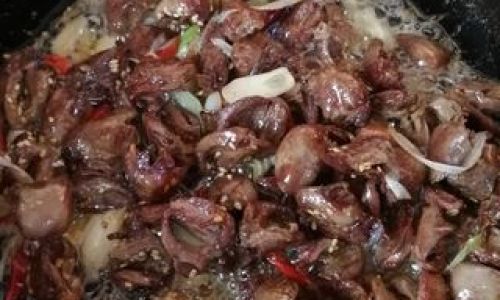
Modern Twists: Global Fusion
Contemporary chefs experiment with bold pairings, such as stir-fried chicken hearts with pineapple salsa, basil pestos, or even truffle oil. These innovations cater to adventurous diners while honoring the dish’s roots.
Health Benefits and Nutritional Profile
Beyond its culinary appeal, stir-fried chicken hearts offer notable nutritional benefits. A 100-gram serving provides:
- Protein: 17 grams (essential for muscle repair and immune function).
- Vitamin B12: Supports nerve health and red blood cell production.
- Iron: Crucial for preventing anemia and fatigue.
- Zinc: Aids in wound healing and immune function.
Compared to lean chicken breast, hearts are higher in cholesterol but also richer in coenzyme Q10, an antioxidant linked to heart health. When stir-fried with minimal oil, the dish remains a relatively low-fat, high-protein option.
Mastering the Dish at Home: Tips and Tricks
For those eager to try their hand at stir-fried chicken hearts, here are expert tips:
- Prep Like a Pro: Marinate the hearts for at least 15 minutes to tenderize them.
- Wok Height Matters: Use a carbon-steel wok if possible; its high sides and excellent heat retention are ideal for stir-frying.
- Batch Cooking: Avoid overcrowding the pan—cook the hearts in batches to ensure even browning.
- Sauce Consistency: Thicken the sauce with a cornstarch slurry if you prefer a glossier finish.
- Garnish Creatively: Top with toasted sesame seeds, crushed peanuts, or fresh herbs for texture.
Pairing Suggestions: Elevating the Meal
Stir-fried chicken hearts pair wonderfully with:
- Rice: Jasmine, basmati, or sticky rice.
- Noodles: Thin egg noodles or udon.
- Beverages: A crisp lager, jasmine tea, or a light-bodied riesling.
- Sides: Steamed bok choy, pickled vegetables, or cucumber salad.
The Psychology of Offal: Overcoming Preconceptions
Despite its culinary merits, offal remains polarizing. In Western cultures, organs are often associated with poverty or deemed “unappetizing.” However, global food trends are shifting this perception. Chefs and food influencers champion nose-to-tail eating, emphasizing sustainability and flavor. Stir-fried chicken hearts, with their approachable preparation and bold taste, serve as an ideal gateway dish for curious eaters.
Conclusion: A Dish That Resonates
Stir-fried chicken hearts are more than a meal—they are a cultural artifact, a culinary adventure, and a testament to human ingenuity. From the streets of Chengdu to the kitchens of Brooklyn, this dish continues to evolve, bridging traditions and innovations. Whether you savor it as a late-night snack or a dinner-party showstopper, one thing is clear: the humble chicken heart, when stir-fried with skill and passion, becomes a symphony of flavor that lingers long after the last bite.
So, the next time you encounter this dish on a menu or dare to cook it yourself, remember: you’re not just eating organ meat. You’re partaking in a millennia-old ritual of turning the ordinary into the extraordinary—one fiery, fragrant, and utterly unforgettable bite at a time.
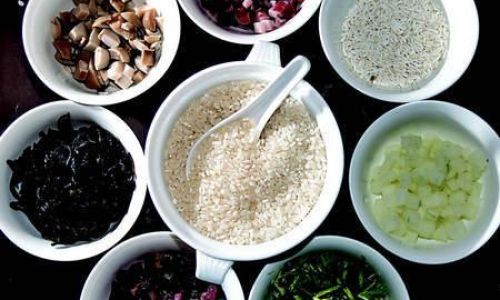
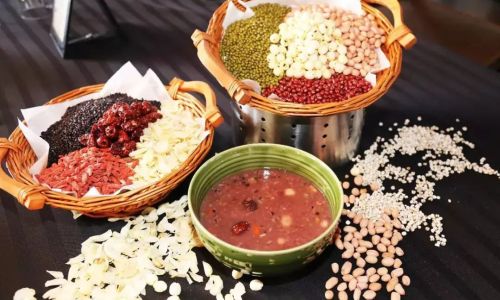
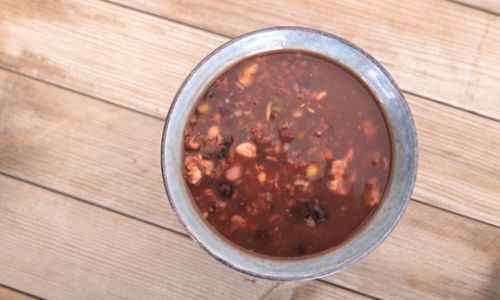


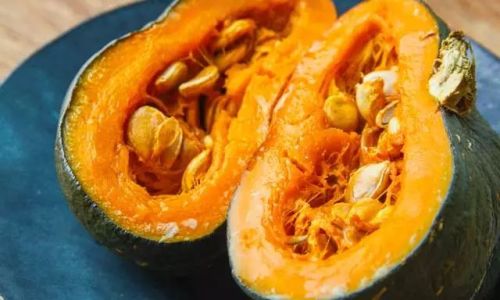
0 comments